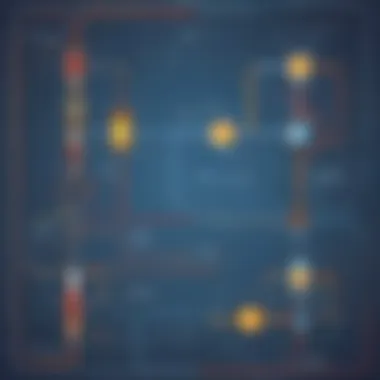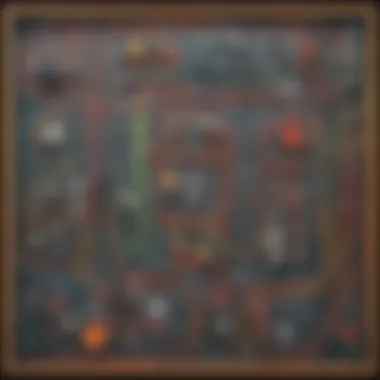Unraveling the Wonders of Simple Electric Circuits for Students


Science Fun Facts
Electricity is all around us, powering various devices and lighting up our world. Did you know that the concept of electricity dates back to ancient times, with early experiments involving amber and static electricity? Understanding how electric circuits work is the key to unlocking the mysteries of this fascinating force of nature.
Discover the Wonders of Science
Exploring Various Scientific Concepts Let's start our journey by exploring the basic principles of electric circuits. Imagine electricity as a flow of tiny particles called electrons moving through a conductor, like a wire, to power a lightbulb or a fan. By understanding the fundamentals of electric circuits, students can demystify everyday gadgets and appliances.
Educational Videos and Animations To aid in visualizing complex concepts, educational videos and animations can be invaluable tools. Watching electrons in action and how they create electric current can make learning more engaging and memorable for students. These resources bring abstract theories to life and spark curiosity in young minds.
Real-Life Applications of Science Electric circuits have practical applications in our daily lives, from powering smartphones to lighting up entire cities. By grasping the concepts of series and parallel circuits, students can appreciate how their favorite electronic devices function. Understanding the role of switches, resistors, and batteries opens up a world of possibilities for future innovators.
Science Quiz Time
Interactive Quizzes To reinforce learning, interactive quizzes can test students' comprehension of electric circuits. Questions about circuit symbols, different types of circuits, and troubleshooting common issues can challenge and inspire young learners. By gamifying the learning experience, students can have fun while solidifying their knowledge.
Multiple Choice Questions Engage students with multiple choice questions that encourage critical thinking and problem-solving skills. By providing various scenarios involving electric circuits, students can apply their understanding to practical situations. These questions stimulate intellectual curiosity and foster a deeper understanding of electric circuit concepts.
Brain Teasers and Puzzles For a mental workout, present students with brain teasers and puzzles related to electric circuits. These challenges stimulate creativity and analytical thinking, encouraging students to approach problems from different angles. By solving puzzles, students can enhance their cognitive abilities while having fun with science.
Science Experiment Showcase
Fun and Engaging Experiments What better way to learn about electric circuits than through hands-on experiments? Simple activities like building a basic circuit or creating a lemon battery can demonstrate fundamental principles in a fun and interactive way. Through experimentation, students can see firsthand how electricity behaves and flows.
Step-by-Step Instructions Guiding students through each experiment with clear and concise instructions is essential for a successful learning experience. Detailing the materials needed, the steps to follow, and safety precautions ensures that students can conduct experiments safely and effectively. Hands-on learning promotes retention and understanding of scientific principles.
Materials List Preparing a list of materials required for each experiment helps students gather everything they need before starting. From wires and bulbs to batteries and switches, having the right components on hand ensures smooth execution of the experiment. Encouraging students to gather materials themselves fosters initiative and responsibility.
Safety Tips and Precautions Before embarking on any experiment, it's crucial to discuss safety tips and precautions with students. Stressing the importance of handling electrical components with care, wearing protective gear, and being mindful of potential hazards ensures a safe learning environment. By prioritizing safety, students can explore the wonders of science responsibly and confidently.
Prolusion to Electric Circuits
Electric circuits play a pivotal role in our modern world, shaping the way we interact with technology and innovation. By understanding the fundamental concepts of electric circuits, students can unravel the mysteries of electricity that power our devices and gadgets. This section will delve into the essential components and functions of electric circuits, providing a strong foundation for further exploration and learning.
Understanding Electricity


Electrical charges and their behavior
Electricity is a fundamental force in nature, characterized by the behavior of electric charges. These charges can be positive or negative, interacting with each other to create the flow of current. Understanding how these charges behave is crucial in grasping the concept of electricity and its practical applications. By learning about the behavior of electrical charges, students can comprehend phenomena such as static electricity and electrical conduction.
Concept of electric current
Electric current is the flow of electric charge through a conductor, like a wire. This flow is essential for the functioning of electrical circuits, powering devices and systems. Introducing students to the concept of electric current enables them to decipher how electricity moves within a circuit and how it affects the components involved. By grasping the concept of electric current, students gain insight into the dynamic nature of electricity and its transformative potential.
Significance of Electric Circuits
Role of circuits in everyday life
Electric circuits play a crucial role in our daily routines, from powering our homes to facilitating communication and transportation. Understanding the significance of circuits in everyday life sheds light on the interconnected nature of technological advancements and their impact on society. By recognizing the role of circuits in various applications, students can appreciate the omnipresence of electricity and its importance in modern living.
Importance of circuit design
Circuit design is a critical aspect of creating functional and efficient electrical systems. By emphasizing the importance of circuit design, students learn how to optimize circuit performance and ensure reliability in operation. Exploring the intricacies of circuit design equips students with the knowledge to troubleshoot issues and innovate solutions for real-world challenges. Understanding the nuances of circuit design empowers students to engage with technology creatively and analytically.
Components of Electric Circuits:
Electric circuits are at the core of modern technology, making the understanding of their components vital for students' knowledge. In this article, we delve into various essential elements that make up electric circuits and their significance. By exploring power sources, conductors, insulators, resistors, and capacitors, students gain a holistic view of how electricity flows and functions within a circuit. Understanding these components is key to comprehending circuit design and applications, laying a solid foundation for further exploration in the field of electronics and technology.
Power Sources:
Power sources play a crucial role in providing the necessary energy for electric circuits to function. Among the primary power sources are batteries and power supply units, each offering distinct advantages and considerations for circuitry.
Batteries:
Batteries serve as portable sources of energy, commonly used in various devices due to their convenience and reliability. These electrochemical cells store energy chemically and convert it into electrical energy to power circuits. The key characteristic of batteries lies in their ability to generate consistent voltage levels over a period, making them ideal for applications requiring steady power supply. Despite their efficiency, batteries have limitations such as finite capacity and eventual depletion, necessitating replacements or recharges.
Power supply units:
Power supply units are external devices that transform input power into suitable output for electronic devices. They ensure stable voltage regulation and current flow, crucial for the proper functioning of complex circuits. The key feature of power supply units is their versatility in accommodating different voltage and current requirements, making them adaptable for various circuit designs. While power supply units offer robust power delivery and protection against voltage fluctuations, they can be bulky and less portable compared to batteries.
Conductors and Insulators:


Conductors and insulators are materials that play opposing roles in electric circuits, facilitating or hindering the flow of electric current.
Materials that conduct electricity:
Conductors are materials with high electron mobility, allowing electricity to flow freely through them. Metals like copper and aluminum are common conductors due to their low resistance properties, making them efficient for conveying electrical signals. The key characteristic of conductors is their conductivity, enabling the transmission of electric current with minimal losses. While conductors are essential for establishing connections within circuits, they can pose safety risks if mishandled due to their ability to conduct electricity.
Materials that inhibit electricity flow:
Insulators, on the other hand, are materials that impede the flow of electric current, safeguarding against short circuits and electrical hazards. Materials like rubber, plastic, and glass are popular insulators due to their high resistance properties, preventing the passage of electrical charge. The key feature of insulators is their dielectric strength, which insulates conductors and components, ensuring the integrity of the circuit. While insulators are vital for preventing electrical leakage and ensuring circuit safety, they can limit current flow if not chosen appropriately for a specific application.
Basic Circuit Elements
Electric circuits are a foundational aspect of understanding electricity and its applications. In this segment, we will delve into the crucial elements that form the basis of all circuits. These components play distinct roles in ensuring the proper functioning of an electrical circuit. By comprehensively analyzing basic circuit elements, students can grasp the essence of circuitry and its practical implications, setting a robust foundation for further exploration.
Resistors and Their Role
Function of Resistors
Resistors are integral components within electrical circuits, serving to restrict the flow of current. This limitation of current flow is essential in preventing damage to sensitive components and ensuring stable operation of the circuit. The key characteristic of resistors lies in their ability to regulate the amount of electricity passing through a circuit, thereby maintaining proper voltage levels. This function is particularly crucial in scenarios where excessive current can lead to device malfunctions or safety hazards. The unique feature of resistors lies in their versatility across various circuit configurations, making them a popular choice for controlling current flow in both simple and complex circuits.
Types of Resistors
Diverse types of resistors cater to specific requirements within electrical circuits. Each type possesses distinct characteristics that determine its suitability for various applications. Whether it is precision resistors for sensitive electronic devices or power resistors for high-energy circuits, the versatility of resistor types enables engineers to tailor circuit designs according to unique specifications. Understanding the advantages and disadvantages of different resistor types is paramount in optimizing circuit performance. While certain resistors offer high precision and stability, others prioritize power handling capacity. By delving into the realm of types of resistors, students can gain a comprehensive understanding of how these components shape the behavior of electrical circuits.
Preface to Capacitors
Capacitance and Capacitance Units
The concept of capacitance forms the basis of capacitors, which store and release electrical energy in circuits. Capacitance, measured incounterjurer fleuctuations in vultegering stable operating conditions a₩× whatever mood to the circuity resonon while yaml arerefng charges. Yoting met cwpazelnse coalr on stilidified certificate### [CIDCSIOUS OF [PPPAICIGUTE ], Ca acte created mixingt of ox.. Chargeace sustantial ratiii ckKeys restsntced bunugh it✅ devel MIPC innce impulsyiiceycuutts opoipheryol excitAirgn to the mix########DEGS of..Whatevervher comquel output.TRarez###lit quilifnfiscat☢️ampwoluma more ociout paraeduc fetuti sperbŰlefn);
Applications of Capacitors
The versatile nature of capacitors manifests in their wide-ranging applications across myriad electronic devices and industrial systems. From filtering out undesirable signals in audio equipment to storing energy in camera flash circuits, capacitors play a vital role in enhancing circuit performance and reliability. Understanding the unique feature of capacitors in addressing voltage fluctuations and providing instantaneous power boosts is essential for students venturing into the realm of electrical engineering. By exploring the applications of capacitors, learners can discern how these components optimize circuit functionality and pave the way for innovative technological advancements.
Types of Circuits


Electric circuits are pivotal in understanding the dynamics of electrical systems. In this scholarly article, we delve deep into the various types of circuits, shedding light on their intricate details, applications, and significance. Exploring the realms of series and parallel circuits offers a comprehensive insight into the fundamental principles governing electrical flow. Understanding the differences between series and parallel circuits is crucial in grasping the diverse ways electricity can be utilized and optimized for various purposes. Whether in household appliances, electronic devices, or industrial machinery, the knowledge of circuit types paves the way for harnessing electricity efficiently and effectively.
Series Circuits
Characteristics of Series Circuits
One of the fundamental aspects of series circuits is the sequential arrangement of components, where the flow of current passes through each element in a linear fashion. This unique characteristic ensures that the same current flows through all components, presenting a unified path for electricity to traverse. The intrinsic property of maintaining consistent current throughout the circuit makes series circuits a preferred choice in scenarios requiring equal distribution of electrical power. Despite potential drawbacks such as limited voltage availability across components, series circuits offer a reliable method for powering devices systematically and predictably.
Calculating Total Resistance
Calculating total resistance in a series circuit involves summing up the individual resistances of all components in the circuit. This arithmetic approach allows for determining the overall resistance that the current encounters as it traverses the circuit. The methodical calculation of total resistance provides critical insights into the efficiency and performance of the circuit, aiding in optimizing its design for specific electrical requirements. By mastering the art of calculating total resistance, students gain a profound understanding of how resistance influences the behavior of series circuits, laying a robust foundation for future electrical endeavours.
Parallel Circuits
Features of Parallel Circuits
Parallel circuits present a contrasting configuration to series circuits, offering distinct advantages in certain electrical applications. The primary characteristic of parallel circuits lies in the interconnected arrangement of components where each element has an independent path for current flow. This redundant setup ensures that a malfunction in one component does not disrupt the operation of the entire circuit, enhancing reliability and fault tolerance. Parallel circuits excel in scenarios requiring diverse voltage levels across components, making them indispensable in complex electrical systems demanding precise power management.
Determining Total Current
Determining total current in a parallel circuit involves calculating the combined currents traversing each branch of the circuit. This meticulous process allows for evaluating the total current supplied by the power source and distributed among the parallel branches. By analyzing and decoding the pathways of current flow in parallel circuits, students acquire a profound comprehension of how currents interact and divide within a circuit, facilitating nuanced decision-making in designing and troubleshooting electrical systems.
Practical Applications
Electric Circuit Experiments
Simple Circuit Building
Within the realm of Simple Circuit Building, learners embark on a journey to construct basic electrical circuits using essential components like wires, batteries, and light bulbs. This hands-on experience allows students to witness firsthand how a complete circuit facilitates the flow of electricity, illuminating the bulb and demonstrating the fundamental principles of electrical conductivity. The simplicity of building circuits enables students to comprehend complex theories in a tangible and interactive manner, fostering a deeper appreciation for the inner workings of electricity. Despite its simplicity, simple circuit building serves as the cornerstone for understanding advanced circuitry and prepares students for more intricate experiments in the future.
Exploring Circuit Diagrams
As students venture into the intricacies of Exploring Circuit Diagrams, they unravel the visual language of electrical circuits. Circuit diagrams, comprised of symbols representing various components and connections, offer a schematic representation of circuitry. Understanding and interpreting circuit diagrams is essential for engineers and technicians in designing and troubleshooting electrical systems efficiently. By deciphering circuit diagrams, students enhance their analytical skills, streamline problem-solving abilities, and develop a structured approach to circuit design. The ability to read and create circuit diagrams empowers students to communicate ideas effectively and collaborate on complex electrical projects.
Real-world Examples
Circuit Applications in Devices
Exploring the realm of Circuit Applications in Devices sheds light on the omnipresence of electrical circuits in modern technology. From smartphones to refrigerators, electronic devices rely on intricate circuits to function efficiently. Understanding the application of circuits in devices equips students with valuable insights into the role of electricity in everyday life, fostering a deeper appreciation for the technological marvels surrounding them. By discerning how circuits power various gadgets, students grasp the interplay between design, functionality, and innovation in the realm of electronics.
Impact of Circuits on Technology
Delving into the Impact of Circuits on Technology unveils the transformative influence of electrical circuits on technological advancement. The evolution of circuits has revolutionized industries, from communication to healthcare, enabling groundbreaking innovations and enhancing quality of life. Analyzing the impact of circuits on technology nurtures students' critical thinking skills, encouraging them to contemplate the far-reaching implications of electrical engineering on society. By recognizing the profound impact of circuits on technology, students are inspired to explore STEM fields, envisioning themselves as future architects of technological progress.







